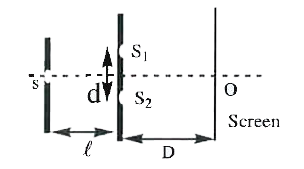Three coherent waves having amplitudes 12mm. 6mm and 4 mm arrive at a given point with successive phase difference of π/2. Then the amplitude of the resultant wave is Solution in Telugu
7mm
10 mm
5 mm
4.8 mm
The correct Answer is:B
Step by step video, text & image solution for Three coherent waves having amplitudes 12mm. 6mm and 4 mm arrive at a given point with successive phase difference of pi//2. Then the amplitude of the resultant wave is by Physics experts to help you in doubts & scoring excellent marks in Class 12 exams.
Topper's Solved these Questions
- BOOK - AAKASH SERIESCHAPTER - WAVE OPTICSEXERCISE - Additional Practice Exercise Level - II (Lecture Sheet (Advanced) Straight objective Type Questions8videos
WAVE OPTICS
- BOOK - AAKASH SERIESCHAPTER - WAVE OPTICSEXERCISE - Additional Practice Exercise Level - II (Lecture Sheet (Advanced) More Than One Correct Answer Type Questions4videos
WAVE OPTICS
- BOOK - AAKASH SERIESCHAPTER - WAVE OPTICSEXERCISE - Practice Sheet Exercise - III (POLARISATION) (Level - II) (Straight objective Type questions)5videos
WAVE OPTICS
- BOOK - AAKASH SERIESCHAPTER - WAVE MOTION AND SOUNDEXERCISE - PROBLEMS (LEVEL - II)81videos
WAVE MOTION AND SOUND
- BOOK - AAKASH SERIESCHAPTER - WAVESEXERCISE - EXERCISE-III (Doppler effect :)15videos
WAVES
Similar Questions
A double slit S1S2 is illuminated by a coherent light of wavelength λ. The slits are separated by a distance d. A plane mirror is placed in front of the double slit at a distance D1 from it and a screen Σ is placed behind the double slit at a distance D2 from it. The screen Σ receives only the light reflected by the mirror. Find the fringe width of the interference pattern on the screen.
 03:26View Solution
03:26View SolutionThe figure shows a schematic diagram showing the arrangement of Youngs's Double Slit Experiment

Choose the correct statement (s) related to the wavelength of light used03:13View SolutionA ray of light in air is incident on a glass plate at polarising angle of incidence. It suffers a deviations of 22∘ on entering glass. The angle of polarisation is
02:06View SolutionA wave is described by the equation
y=(1.0mm)sinπ(x2.0cm−10.01s)
Find the time period and the wavelength.01:58View SolutionWhen a train is approaching the stationary observer, the apparent frequency of the whistle observed as 100 Hz, while when it has passed away from the observer with same speed, it is 50 Hz. Calculate the frequency of the whistle when the observer moves with the train (V = 330 m/s)
02:12View SolutionThree coherent waves having amplitudes 12mm, 6mm and 4mm arrive at a given point with successive phase difference of pi/2 . Then, the amplitude of the resultant wave is
03:12View SolutionThree waves of equal frequency having amplitudes 10μm, 4μm and 7μm arrive at a given point with successive phase difference of π/2, the amplitude of the resulting wave in μm is given by
04:45View SolutionThree waves producing displacement in the same direction of same frequency and of amplitudes 10ηm,4ηm and 7η m arrive at a point with successive phase difference of π/2. The amplitude of the resultant wave is :--
01:18View SolutionThree waves of equal frequencies having amplitudes 10μm,4μmand7μm arrive at a given point with successive phase difference of π/2.
The amplitude of the resulting wave in μ m is given by03:23View SolutionThree waves of amplitudes 7 mm, 3 mm and 11 mm with a successive phase difference of π2 are super - imposed. The amplitude of the resulting wave will be
02:12View SolutionThe phase difference between two waves reaching a point π2. What is the resultant amplitude. If the individual amplitude are 3 mm and 4mm ?
02:11View SolutionThree coherent waves having amplitudes 12mm. 6mm and 4 mm arrive at a given point with successive phase difference of π/2. Then the amplitude of the resultant wave is
02:17View SolutionThree waves of equal frequency having amplitudes 10 mm, 4 mm and 7 mm superpose at a given point with successive phase difference of pi /2 . The amplitude of the resulting wave in mm is given by
01:44View SolutionThree waves of equal frequency having amplitudes 10μm, 4μm, 7μm arrive at a given point with successive phase difference of π/2, the amplitude of the resulting wave in μm is given by
04:39View SolutionThree coherent waves having amplitudes 12mm, 6mm and 4mm arrive at a given point with successive phase difference of pi/2 . Then, the amplitude of the resultant wave is
02:17View Solution

